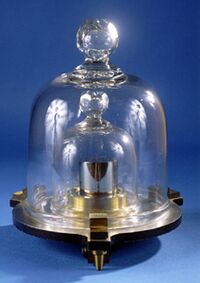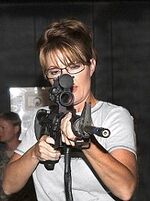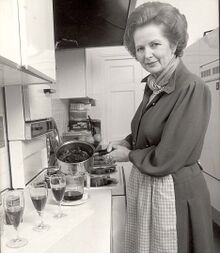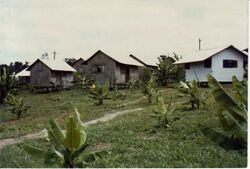Kilogram

The kilogram or kilogramme (SI unit symbol: kg), is the base unit of mass in the International System of Units (SI) (the Metric system). It was first defined as the mass of the smallest stone that will break a human skull using a cricket bowling action. The original prototype kilogram was manufactured in 1799 after many headaches and a few successful deaths. It had a mass equal to the mass of about 1.000028 dm³ of water at about 4° C, so it is not actually a kilogram, but it is "close enough for government work."
The kilogram is the only SI base unit with an SI prefix ("kilo", symbol "k") as part of its name, except the kilometre which is a distance, and the kilo, which is how much something weighs. High-school physics students struggle to figure out why the kilogram is the "base" unit and not the gram that it is based on.
The kilogram is also the only SI unit still defined by an artifact that has to be borrowed, rather than a physical property that could be reproduced in different laboratories, except the artifact neither weighs a kilo nor is 1 kg in mass.
Name and terminology
Kilogram is borrowed from the French kilogramme, which itself was purloined from somewhere else, prefixing the Greek stem of χίλιοι (khilioi, "a thousand") to γράμμα (gramma, Grandma, probably).
The United Kingdom adopted the French spelling in 1797 when first using the word in English, at about the same time London restaurants were adopting rich French sauces, though in both cases patrons could scrape them off. The break-away American colonies, as they were nowhere near France and would not even consider French help in a rebellion, dropped the "surplus" letters from the end of the word in a snub of the Crown. Magnanimously, the U.K. maintained its worldwide empire by being non-committal and allowing both spellings.
UK law regulating the units to be used when trading by weight or measure still permits both spellings. Since the kilogram is not a weight anyway, the decision has no bearing on arguments over buying bags of loose potatoes or humbugs.
History
The International Prototype Kilogram was commissioned under the authority of the Metre Convention (1875). Unfortunately, it varied in mass over time relative to its reproductions. The International Committee for Weights and Measures recommended in 2005 that the kilogram be set in terms of a fundamental constant of nature, such as how much does it weigh on a set model of Poundland bathroom scales (although they often lie too).
Even less fortunately, as kilogram is a mass not a weight, the International Committee for Weights and Measures had no authority to define it. They deferred to the International Committee for Mass, which fortunately happened to be meeting in Vatican City in 2011. They defined the kilogram in terms of the Planck constant. The decision was deferred until 2014, while they found a planck that had a mass of a kilogram.
Mass versus weight
As a unit of mass not weight, the kilogram reflects the fact that just because there is a lot of something doesn't mean it is terribly heavy, something of interest to the buyer of potatoes no less than to the killa. Isaac Newton or Albert Einstein taught us the difference, though the former used apples and the latter used only his loaf.
Sticking with murder as a more accessible example than buying produce: on earth, striking a victim on the head with a kilo will fracture his skull, as would striking him with a kilogram. However, according to BBC 4's Professor Brian Cox (pictured), in orbit there is no gravity, so striking the victim with a kilo will do nothing, because the kilo is weightless. Hitting him with a kilogram, however, will still kill him.
Often a gun is the answer. However, accounting for time and petrol (unless you can get one from next door), a kilogram bowled at the head, cricket-style, in space still kills with the fewest kilojoules, considering the kj used in the charge, and in the blast furnace used to create the gun. This is why, rather than two kilojoules "in the hat," killaz aim for the family joules.
Prototypes
As committee after committee refused to declare that a kilogram "is this much of this," but rather, "here is something that is just about right," it has been necessary to fabricate, guard, and caress various prototypes having just about 1 kg of mass. Each has a flowery history of its own. None can be physically handled, as scientists would then have to modify any measurements to compensate for fingertip oil, dander, and boogars.
Arago
The Arago kilogram is an exact copy of the French Kilogramme des Archives commissioned by the US under supervision of French physicist François Arago. It served as a paperweight on the President's desk until 1889, when President Benjamin Harrison said he had never had to shuffle paper in Indiana and would have none of it now. However, others in his Administration managed to convert the US to primary metric standards, and it received kilogram prototypes K4 and K20.
Two were required, as just one would have nothing to compare to as a control; which was fortunate, because both prototypes, the Arago kilogram and the French version were indeed completely different masses — and none of them weighed 1 kg. Fortunately for the US, the exercise quickly became academic, as none of the nation's recipe books seemed to work using mass anyway. In the end, most people went back to pounds and ounces, which tended to remain constant.
International Prototypes
Since 1889, 1 kg has been defined as the mass of the International Prototype Kilogram-ish, or "IPK" — a glimmering cylinder of platinum–iridium alloy 39.17 mm in both diameter and height. Its edges have a bold chamfer to minimize the wear it undergoes as it sits in a jar being looked at occasionally.
Six sister copies reside at France's International Bureau of Weights and Measures in an environmentally monitored safe, located in a basement vault underneath the Pavillon de Breteuil, whose fire doors they are currently wedging open. Official copies of the IPK were provided to other nations to serve as their national standards. Standard of what, precisely, the nations are still discussing, but France is adamant that they are not to be used to play cricket. These copies are compared to the IPK roughly every 40 years, just in case any two weigh the same.
In other countries
United States
The United States has officially been on the kilogram since an act of Congress in 1886, and yet again in 1966, when all Americans clamored for a standard unit of measure to ensure fair practice by the influx of drug dealers with scales. President Jimmy Carter promoted SI as part of his panoramic effort to align the governance of the U.S. with that of Venezuela. Later, SI made a resurgence in the campaign of Barack Obama, whose main slogan was, "SI se puede."
Despite this, all that Americans know about the Metric system is that, when a grocer converts his produce aisle to the kilogram, you suddenly start getting 2.2 times less of everything for your dollar. At present the only use of the SI, outside university laboratories where co-eds who don't want to deal with measurement can receive "trigger warnings" to retreat to a "safe zone," is that posted vehicle weight limits on Interstate 19 in Arizona are in kilograms as an aviso to illegal Mexicans journeying toward the unpatrolled parts of the desert near Tucson.
United Kingdom
For decades, Britain's position on baroque traditional measurement of weights was like a Tory politician on abortion: disgusting but not rising to the level of doing anything about it. However, in 1965, the Government forced metrification on the country. Prime Minister Harold Wilson claimed the switch to kilogrammes satisfied the wishes of the baking industry, but he could not produce any baker to say he had requested it; many insisted they had plenty of pounds. In fact, in 1972, PM Edward Heath discovered that Brussels had been behind it, putting the finishing touches on an unissued directive to mandate the use of kilogrammes throughout the Common Market. Heath was taking Britain's sponge cakes to Europe and had to keep Brussels' intentions behind wax paper until Britain was irrevocably committed to voluntary union.
In 1968, technology minister Tony Benn accidentally tweeted that MPs wished to see the conversion completed by 1975. He quickly added that the change would not use compulsion, and thus did not need parliamentary debate either. Thus, a quick new law gave shop owners the voluntary option of selling by the kilogramme or changing their profession to interior decoration and working on a prison cell. The new national Metrification Board ruled it illegal for schools to teach how to convert kilogrammes to anything else.
Government sought to mollify critics by allowing them to keep the other pound, though the shilling was recalled in favor of the decipound and the loyal British penny was replaced with the centipound. However, citizens could still celebrate Guy Fawkes' Day as always.
In 1980, PM Margaret Thatcher scrapped the Metrification Board and re-legalised Imperial measurements, though the new generation had not been taught how to multiply by 16. This forced Brussels to issue the directive dispensing with the "voluntary" pretense and mandating the use of kilogrammes throughout the European Community. A further directive sought to bring Britain into line, though it still allowed pubs to dispense pints, avoiding a move Britons would regard as an overt act of war.
The Conservative Party responded to this and other controversies by replacing Thatcher with John Major and his "Back to Basics" campaign, which enshrined the European diktat in British law, even though no one in Europe could still say how much a kilogram actually is. Before long, a Sunderland shopkeeper was criminally charged with selling a pound of bananas.
The Court of Appeal had cited the ancient rule that no Act of Parliament can be overruled by one passed previously, so the 1985 Weights And Measures Act could not be negated by an edict issued under the European Communities Act of 1972. However, Lord Justice Laws ruled that the European Communities Act was essentially "constitutional" and could not be overturned by subsequent law. The food industry welcomed the move, converted tins of "1 lb (454g)" to a compliant 400g, and charged the same price. Britain allowed pounds and ounces to be printed alongside kilogrammes, but Belgium, somehow not just writing Britain's constitution but exercising its veto, outlawed that practice too.
The UK could not stand that random Londoners, asking why The Sun kept putting 15-stone models on Page Three, would now have to go to prison for the remark. It sought an even higher authority: the EU's defense department, based in Washington, D.C. London told U.S. multinational corporations that having ASDA sell imported "pound" cake would now be a crime. Before a single B17 could be launched against the Continent, a red-faced EU trade commissioner fawned that Imperial measurements "were the very essence of Britishness" and that the British could use quaint alternatives alongside the kilogramme indefinitely. Future discussion would be confined to how small the print had to be to avoid loss of licences.
Guyana
It is not only in economic-powerhouse nations that forcing everyone to change personal behavior and discard all their bathroom scales is a virtual tenet of statecraft, compared to simply attaching stickers as imports arrive at the pier.
Yet, as Winston Churchill said, "We in government have nothing to fear — but government itself." Thus, the European Space Agency's Guyana Space Center at Jonestown, set up to give an equatorial boost both to launched satellites and to junketing Members of the European Parliament, launched an 82-pound earth science probe, the Ersatz I. Imagine the surprise on the scientists' faces when they discovered that the payload was actually 82 kilogrammes, just after it fizzled and executed a signature "ground loop." Mortified project managers drowned their sorrows in Kool-Aid and coined the persistent saying that the beauty of standards is that there are so damned many of them.
See also
| Featured version: 17 March 2016 | |
| This article has been featured on the main page. — You can vote for or nominate your favourite articles at Uncyclopedia:VFH. | |







